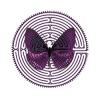Growing greenhouse plants with Light Emitting Plasma Diode Lights (LEP)

This article originally appeared on Greenhouse Gnome.
I first became interested in light and light quality in high school when everyone had a set of black light posters in their bedrooms. A black light is actually a lamp that generates ultraviolet light that we cannot see. The light emitted is UVA (400-315 nm) radiation. This is not UVB (315-280 nm), which is harmful. Human normal vision perceives light between 380 and 760 nm. When a black light shines on a poster with fluorescent dyes, it glows brightly—what you see glowing are phosphors.
Modern laundry detergents contain phosphors that will convert UVA radiation to white light, which is why white T-shirts glow brighter than in normal sunlight. So, don’t wear a white shirt when playing laser tag or you will lose… a dirty trick played on me by my teenage sons, I will admit!
Laser tag aside, light manufacturers have been designing bulbs for growing plants for as long as we’ve wanted to grow plants indoors. Lamps include incandescent bulbs, fluorescent tubes, high pressure sodium, metal halide and mercury vapor bulbs. There have been many advances in bulb design including dual spectra and switchable lamps. New advances in light emitting diodes (LED) are quickly changing the types of lighting we use for plant growth. (For more information visit LED Lighting in Horticulture.)
The critical issue when choosing a light source for growing plants is to understand the action spectra plant growth. Plants absorb light primarily in the blue and red wavelengths. Conversely, plants reflect light in the green wavelengths. The challenge for adopting lamps for growing plants indoors has been choosing the right bulb. Most lamp manufacturers report their lamps in terms of color temperature. What we think of as cool colors, blue-white, are at temperatures over 5,000°K and warm colors, yellowish white through red, are at color temperatures between 2,700-3,000°K.
Color and light perception have been long studied and human color perception was first elegantly displayed in 1931 by the Commission Internationale de l’Eclairage (CIE) and advanced in 1978.
Which looks more like this for individual lamps:
Most professional growing operations use high pressure sodium lamps, but this is likely to change in the future as lamp technologies improve. One new technology that we at Colorado State University evaluated was a light emitting plasma lamp or LEP. This lamp was introduced to us by the Polar-ray company in Boulder, Colorado. The LEP lamp was the Stray Light PlasmaGrow G-1 manufactured by the Luxim Company. (For the design specifications on the exact lamp we used see: LiFi-STA-40-02.) So we put it to the test.
John Ray, Floriculture Research Associate and Plant and Environmental Research Center Greenhouse Manager, and his practicum students grew four bedding plant species: basil, snapdragon, tomato and zinnia, under two supplemental light sources, high pressure sodium (HPS) and light emitting plasma (LEP). The lamp height between the two were adjusted so that all plants received similar levels of photosynthetic active radiation (PAR). The lamps provided 18 hours of supplemental light in a polycarbonate-glazed greenhouse.
The spectral irradiance is displayed on the graph below:
As you can see, the lamps are not similar in spectra, but what is the impact on plant growth? Dry weight data between the four species showed little difference between the two light sources.
Which lamp would you choose? First, you would have to look at price. the LEP lamps are fairly pricey coming it at $1,350 compared to a HPS for around $300. Energy consumption however, may be a different story. The LEP lamp used consumes 273 watts where the HPS lamp used consumes 1,000 watts. So how does one determine efficiency?
Most lamp manufacturers will report their lamp intensity in lumens. Luminous energy is light output in the visible spectra. The luminous energy rating for the LEP lamp was 14,000 lumens and for the HPS lamp, 110,000 lumens. That makes the luminous efficiency for the LEP lamp at 51.3 lumens/watt and the HPS at 110 lumens/watt. But is that relevant?
There are two forms of chlorophyll: chlorophyll a and chlorophyll b. Chlorophyll absorbs the greatest amount of light energy at 430 nm and chlorophyll b absorbs the greatest amount of light energy at 662 nm. There are other carotenoids involved, but that is beyond what we’re discussing here.
Which one do you choose? That’s up to you.
Republished from CSU Extension Greenhouse Advisor (Creative Commons BY).
The post Growing greenhouse plants with Light Emitting Plasma Diode Lights (LEP) appeared first on Greenhouse Gnome | Everything about greenhouses, nothing about gnomes.
For more articles about greenhouses, visit Greenhouse Gnome.
Source: http://www.greenhousegnome.com/light-emitting-plasma-diode-lights-lep/
Anyone can join.
Anyone can contribute.
Anyone can become informed about their world.
"United We Stand" Click Here To Create Your Personal Citizen Journalist Account Today, Be Sure To Invite Your Friends.
Please Help Support BeforeitsNews by trying our Natural Health Products below!
Order by Phone at 888-809-8385 or online at https://mitocopper.com M - F 9am to 5pm EST
Order by Phone at 866-388-7003 or online at https://www.herbanomic.com M - F 9am to 5pm EST
Order by Phone at 866-388-7003 or online at https://www.herbanomics.com M - F 9am to 5pm EST
Humic & Fulvic Trace Minerals Complex - Nature's most important supplement! Vivid Dreams again!
HNEX HydroNano EXtracellular Water - Improve immune system health and reduce inflammation.
Ultimate Clinical Potency Curcumin - Natural pain relief, reduce inflammation and so much more.
MitoCopper - Bioavailable Copper destroys pathogens and gives you more energy. (See Blood Video)
Oxy Powder - Natural Colon Cleanser! Cleans out toxic buildup with oxygen!
Nascent Iodine - Promotes detoxification, mental focus and thyroid health.
Smart Meter Cover - Reduces Smart Meter radiation by 96%! (See Video).







Great info here. Thanks for sharing. You can also check out http://growblu.com/ for more info about LED grow lights.